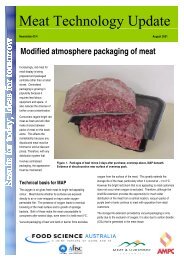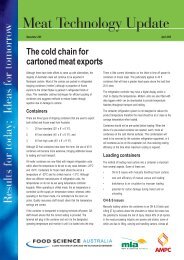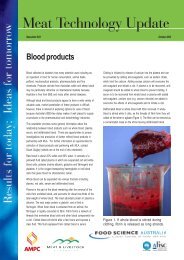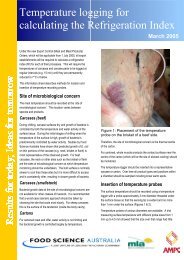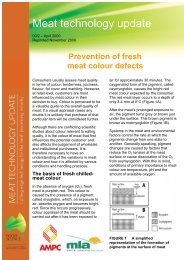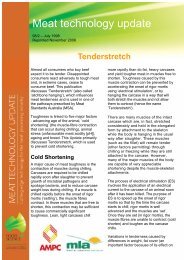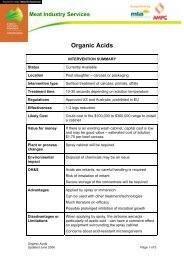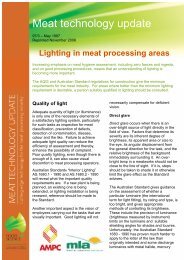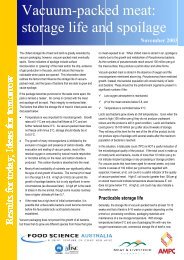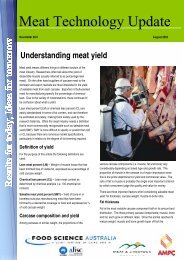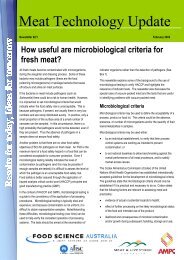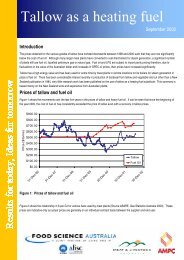Processing factors affecting sheep meat quality. - Meat Industry ...
Processing factors affecting sheep meat quality. - Meat Industry ...
Processing factors affecting sheep meat quality. - Meat Industry ...
You also want an ePaper? Increase the reach of your titles
YUMPU automatically turns print PDFs into web optimized ePapers that Google loves.
<strong>Meat</strong> technology update<br />
6/05 – December 2005<br />
<strong>Processing</strong> <strong>factors</strong><br />
<strong>affecting</strong> <strong>sheep</strong> <strong>meat</strong> <strong>quality</strong><br />
MEAT TECHNOLOGY UPDATE<br />
Cutting-edge technology for the <strong>meat</strong> processing industry<br />
Careful selection of processing procedures can do much to optimise the retail acceptability and tenderness of lamb.<br />
A survey of <strong>sheep</strong> <strong>meat</strong> from Australian retail outlets<br />
in the late 1990s indicated that there was considerable<br />
variation in tenderness. A key finding was that 20%<br />
of lamb samples purchased during the study were<br />
likely to have been unacceptably tough to consumers.<br />
Encouragingly, surveys indicated that 75% of consumers<br />
would purchase more lamb if they had access to tender<br />
and tasty product.<br />
Consequently, <strong>Meat</strong> & Livestock Australia and the<br />
Sheep<strong>meat</strong> Council of Australia initiated a series of<br />
research projects under the Sheep <strong>Meat</strong> Eating Quality<br />
(SMEQ) program. The projects covered <strong>sheep</strong> <strong>meat</strong><br />
production from animal breeding through production,<br />
processing, retailing and cooking methods. A feature of<br />
the SMEQ program was that the <strong>meat</strong> acceptability was<br />
assessed by consumer taste panels, as the consumer was<br />
considered to be the ultimate arbiter of overall product<br />
eating <strong>quality</strong>.<br />
Post-slaughter <strong>factors</strong> have a significant influence on<br />
the eating <strong>quality</strong> of <strong>sheep</strong> and lamb <strong>meat</strong>. This <strong>Meat</strong><br />
Technology Update provides information for processors<br />
on how to optimise <strong>sheep</strong> <strong>meat</strong> eating <strong>quality</strong> and covers<br />
<strong>factors</strong> such as electrical stimulation (ES), hanging and<br />
cooling, and <strong>meat</strong> ageing. Some <strong>factors</strong> that influence<br />
retail display life are also discussed.<br />
The application of best practice based on research results<br />
from the <strong>sheep</strong> <strong>meat</strong> eating <strong>quality</strong> program, including<br />
application of ES or tenderstretch, has resulted in improved<br />
tenderness of lamb purchased by the consumer (Figure 1).<br />
Far fewer tough samples are encountered meaning that<br />
consumers are less likely to have a poor eating experience.<br />
Electrical stimulation<br />
Post-slaughter electrical stimulation (ES) of <strong>sheep</strong> and lambs<br />
has been available for many years, but its use has been limited<br />
because the recommended high voltage systems required<br />
expensive safety housing and barriers. The high voltage<br />
Count<br />
Count<br />
80<br />
70<br />
60<br />
50<br />
40<br />
30<br />
20<br />
10<br />
0<br />
160<br />
140<br />
120<br />
100<br />
80<br />
60<br />
40<br />
20<br />
0<br />
1 2 3 4 5 6 7 8 9 10 11<br />
Shear Force (kg)<br />
1 2 3 4 5 6 7 8 9 10 11<br />
Shear Force (kg)<br />
1997/98 retail audit (n = 907)<br />
SMEQ R&D best practice (n = 806)<br />
Figure 1: Improved lamb loin tenderness resulting from<br />
SMEQ R&D (After Pethick, 2005)<br />
systems used an alternating wave form with peak voltages<br />
of 1100 volts at a pulse rate of 14 pulses per second. New<br />
waveforms have been developed which use short-duration<br />
pulses (at 14 per second) with a peak voltage of about 300 V<br />
(Figure 2). The effective voltage (RMS) is considered safe and<br />
no special protection is required.<br />
ES results in a rapid fall in muscle pH and allows carcases to<br />
be rapidly cooled without inducing toughening due to cold<br />
shortening; however, carcases can be over-stimulated and<br />
enter rigor too early resulting in toughening due to heat<br />
shortening, increased drip loss and pale <strong>meat</strong> colour. The new<br />
technology systems will allow the amount of stimulation to be<br />
tailored to the application.<br />
Mid-voltage ES (i.e. approx. 36 V RMS) can be applied to<br />
dressed carcases at the end of the slaughter line (Figure 3). The
PAGE 2 • <strong>Meat</strong> Technology Update • DECEMBER 2005 •<br />
+1100<br />
V<br />
+300<br />
V<br />
-1100<br />
V<br />
0<br />
Original High Voltage<br />
(HV)<br />
Stimulation<br />
Figure 2: Electrical stimulation waveforms<br />
application electrode can be divided into individual sections to enable<br />
control of the stimulation dose to individual carcases and it is relatively<br />
safe, so it is easier and cheaper to install. New systems are also available<br />
for application to pelt-on carcases at the beginning of the process chain.<br />
Hanging and cooling<br />
Carcases may be hung by either the traditional Achilles tendon<br />
method or suspended by a hook placed under the pubic symphysis<br />
- tenderstretched. In the tenderstretch method many of the valuable<br />
muscles of the loin and hindquarter are restrained and prevented from<br />
contracting due to cold shortening during chilling. After rigor mortis,<br />
the carcases can be hung again by the Achilles tendons.<br />
The effect of tenderstretching on sensory scores of three different<br />
muscles (Table 1) showed that tenderness and overall liking scores were<br />
increased for the longissimus (loin muscles) and biceps femoris (major<br />
Table 1: Effect of Tenderstretch on mean sensory<br />
scores<br />
Muscle Tenderness Overall Liking*<br />
longissimus<br />
Normally hung 60.0 59.4<br />
Tenderstretch 65.2 62.7<br />
biceps femoris<br />
Normally hung 52.5 55.8<br />
Tenderstretch 57.0 58.2<br />
serratus ventralis<br />
Normally hung 59.4 55.8<br />
Tenderstretch 59.1 58.2<br />
* Overall liking included juiciness and flavour as well as tenderness<br />
New Mid Voltage<br />
(MV)<br />
Stimulation<br />
Electrical Stimulation Waveforms<br />
(14 pulses per second)<br />
leg/silverside muscle), but there was little effect on the serratus ventralis<br />
(brisket).<br />
The relationship between <strong>meat</strong> temperature at pH 6 (temp@pH6) and<br />
overall liking for tenderstretch and normally hung carcases is shown in<br />
Figure 4. In normally hung carcases the highest scores occurred at a<br />
temp@pH6 of about 21°C. In contrast, scores for the tenderstretched<br />
carcases were relatively insensitive to a wide range of cooling conditions.<br />
At low temp@pH6 (30°C), then the normally hung<br />
carcases would presumably have ‘heat-shortened’. High temp@pH6<br />
results in exhaustion of protease activity which reduces the tenderising<br />
effect of ageing and in some cases toughens the <strong>meat</strong>.<br />
If processing conditions are managed such that extremes in temperature<br />
at pH 6 are avoided (temp@pH6 between 10°C and 30°C), the benefit of<br />
tenderstretching is small. However tenderstretching provides a measure<br />
of insurance for eating <strong>quality</strong> of loin and leg muscles.<br />
Overall liking score<br />
66<br />
64<br />
62<br />
60<br />
58<br />
56<br />
54<br />
52<br />
50<br />
0 5 10 15 20 25 30 35 40<br />
Temperature at pH 6 (°C)<br />
<strong>Meat</strong> ageing<br />
Normally hung<br />
Tenderstretched<br />
Figure 4: Relationship between overall liking and temperature at<br />
pH 6<br />
Holding <strong>meat</strong> for an extended period in a chilled state is known as ageing.<br />
Ageing is the sum of a number of biochemical reactions, principally<br />
proteolysis, which can continue at chilled temperatures. It is particularly<br />
affected by two easily monitored inputs—temperature and time.<br />
In one SMEQ trial, ageing at 1°C for 5 or 14 days (Table 2) resulted in an<br />
improvement in tenderness when compared with holding for only 2 days.<br />
The major improvement occurred between 2 and 5 days,<br />
with little subsequent improvement up to 14 days.<br />
Table 2: Effect of ageing on mean sensory<br />
scores<br />
Tenderness Overall Liking*<br />
longissimus<br />
2 days 58.1 58.5<br />
5 days 66.4 62.6<br />
14 days 65.9 62.0<br />
biceps femoris<br />
2 days 52.8 55.8<br />
5 days 57.3 59.0<br />
14 days 54.2 56.2<br />
Figure 3: Mid voltage stimulation of the dressed carcase<br />
serratus ventralis<br />
2 days 57.1 60.8<br />
5 days 58.9 60.5<br />
14 days 61.7 59.9<br />
* Overall liking included juiciness and flavour as well as tenderness
<strong>Meat</strong> Technology Update • DECEMBER 2005 • PAGE 3<br />
The temperature at which lamb is aged will depend on the particular<br />
market. The time-temperature profile suited to export markets involves<br />
rapid carcase chilling, vacuum packaging, and maintenance of a chilled<br />
storage temperature as cold as possible (as low as -1.5°C) through to the<br />
point of preparation for retail sale. Although ageing may be slowed by<br />
the low temperature, good microbiological <strong>quality</strong> will be maintained<br />
and the time—normally several weeks—will be ample for ageing.<br />
In the domestic market, where lamb may be sold within a few days of<br />
slaughter, carcase chilling may be slower and the storage temperature<br />
can be higher, say 0–2°C. This contributes to faster ageing to achieve<br />
optimum <strong>meat</strong> <strong>quality</strong> in as little as 3 to 4 days for tenderstretched or ES,<br />
Achilles-hung product.<br />
Retail display life<br />
The colour and colour stability of packaged fresh lamb are important<br />
qualities contributing to retail acceptability. Fresh <strong>meat</strong> is perceived to<br />
be red, preferably bright red, and certainly not brown due to the surface<br />
formation of metmyoglobin. <strong>Meat</strong> tends to brown more as storage time<br />
and storage temperature increase.<br />
Lamb in the Australian market may be distributed to retail outlets as<br />
hanging carcases, or as primals or carcase parts that are:<br />
• naked (unwrapped);<br />
• wrapped in stretch film or permeable bags;<br />
• packed in vacuum packs;<br />
• packed in modified atmosphere packs (MAP) in a gas<br />
atmosphere that is solely or predominantly CO 2 , or<br />
• packed as retail cuts in high-oxygen MAP packs.<br />
For export, primals and carcase parts are vacuum-packaged. Whole<br />
carcases or primals may also be packaged in high-CO 2 MAP.<br />
When the product is handled as carcases or carcase parts, it is<br />
processed at the retail outlet into retail cuts. In most supermarkets<br />
it is then presented on plastic or expanded polystyrene (EPS) trays<br />
and over-wrapped with clear PVC film, which has a high oxygen<br />
permeability. A shortcoming of this approach is that retail display<br />
life may be short—limited to as little as one day if it has been stored<br />
for some time in vacuum or MAP packs prior to being prepared for<br />
retail sale.<br />
The alternative to preparation of retail cuts in stores is centralised<br />
packaging of retail cuts in modified atmospheres that restrict<br />
microbiological growth and prolong retail display life by maintaining<br />
the attractive red colour. The modified atmosphere gas mixtures<br />
most frequently used for retail display of fresh <strong>meat</strong> contain 70–80%<br />
oxygen and 20–30% CO 2 . High oxygen levels maintain the bright red<br />
oxymyoglobin bloom while the CO 2 slows microbiological growth. For<br />
the benefit of this atmosphere to be maximised, the packs have to be<br />
big enough. The ratio of gas volume to <strong>meat</strong> volume has to be at least<br />
1:1; although 1.5:1 is better. The storage life of lamb in high-O 2 MAP is,<br />
however, limited to around 10 days at 0–1°C.<br />
In one of the SMEQ experiments, lamb loin chops and leg steaks were<br />
prepared from primal cuts that had been aged for 7, 21 or 35 days and<br />
then either packed in high-O 2 atmospheres or overwrapped on EPS<br />
trays. They were assessed at the mid point (day 3 and 5 for overwrapped<br />
and MAP respectively) and end point (day 5 and 9 for overwrapped and<br />
MAP respectively) of their expected display life.<br />
At the time of slaughter, the carcases were stimulated with either of<br />
two different wave forms, or unstimulated. It was found that electrical<br />
stimulation did not influence <strong>meat</strong> colour of bone-in loin chops or<br />
boneless leg steaks when assessed at the initial, mid and end of product<br />
display life.<br />
The retail acceptability of lamb cuts displayed in MAP packs was<br />
superior to that of cuts packaged on overwrapped trays (Figure 5). It<br />
was also clear that after 3 and 5 days display, leg steaks (quadriceps<br />
femoris) were inferior to the loin chops regardless of the packaging<br />
method. The acceptability of both loin chops and leg steaks was limited<br />
by browning due to metmyoglobin formation.<br />
Overall acceptability<br />
90<br />
80<br />
70<br />
60<br />
50<br />
40<br />
30<br />
20<br />
10<br />
0<br />
0 1 2 3 4 5 6 7 8 9 10<br />
Length of retail display (days)<br />
Figure 5: Effect of packaging method on retail display life<br />
The ageing period as primal cuts also affected the acceptability at the<br />
nominated mid-point of display life. The acceptability of the overwrapped<br />
retail cuts from lamb primals aged for 21 days was superior<br />
to that of cuts from primals aged for 35 days (Figure 6). On this basis<br />
it appears that for optimum results, lamb primals can be aged for 21<br />
days in vacuum bags at 0°C before preparation into retail cuts. The trial<br />
results support previous findings that when lamb is stored in vacuum<br />
packs for six weeks or longer, the subsequent retail display life will be<br />
reduced. This has clear implications for lamb that is exported.<br />
Overall acceptability<br />
70<br />
60<br />
50<br />
40<br />
30<br />
20<br />
10<br />
MAP loin MAP leg Overwrap loin overwrap leg<br />
0<br />
0 5 10 15 20 25 30 35 40<br />
Ageing period (days)<br />
Overwrap loin<br />
overwrap leg<br />
Figure 6: Effect of ageing period on acceptability at the midpoint<br />
of display life<br />
To achieve the multiple benefits of centralised packaging of retail<br />
cuts—a storage life longer than two weeks and good retail display<br />
life—it is necessary to go to systems where the retail packs can be held<br />
in a high-CO 2 environment until needed for retail display. The oxygenimpermeable<br />
film is then removed, allowing oxygen to reach the <strong>meat</strong><br />
surface so the <strong>meat</strong> blooms. Examples are the peelable vacuum skin<br />
pack and the ‘mother’ pack.
PAGE 4 • <strong>Meat</strong> Technology UPDATE • DECEMBER 2005<br />
Table 3: Key outcomes from SMEQ trials<br />
<strong>Processing</strong> Factor<br />
Impact on Eating Quality<br />
Electrical stimulation • Electrical stimulation, applied correctly, will ensure <strong>sheep</strong> <strong>meat</strong> enters rigor at<br />
the correct temperature.<br />
• New generation mid-voltage electrical stimulation applied via a rubbing rail<br />
to skin-off carcases is recommended.<br />
• When correctly applied, electrical stimulation has no effect on display-life colour.<br />
• Where lamb is aged for longer than about 3 days, electrical stimulation may not be<br />
required where carcases enter rigor between 8 and 30°C.<br />
Carcase chilling • Rapid chilling can increase toughness.<br />
• For optimal acceptability, conventionally hung carcases should enter rigor (pH 6) at<br />
between 13 and 27°C.<br />
• The temperature at rigor has little effect on eating <strong>quality</strong> of tenderstretched carcases.<br />
Hanging method • Tenderstretch is particularly beneficial to the eating <strong>quality</strong> of loin and hindquarter cuts.<br />
• Tenderstretch is an alternative to electrical stimulation for achieving good eating <strong>quality</strong>.<br />
Ageing • Ageing takes place progressively and occurs more rapidly at higher temperatures.<br />
• Ageing at low temperatures (-1.5°C) is suited to the chilled export trade.<br />
• Ageing at a temperature of 1–2°C for 5 days will achieve optimum eating <strong>quality</strong> for the<br />
domestic market.<br />
Retail packaging • MAP packs have a longer retail display life than PVC overwrap packs.<br />
Further reading<br />
Channon, H.A., Baud, S.R. and Walker, P.J. (2005) Modified<br />
atmosphere packaging improves retail display life of lamb cuts<br />
with variation between loin and knuckle. Australian Journal of<br />
Experimental Agriculture, 45: 585-692.<br />
Shorthose, W.R., Powell, V.H. and Harris, P.V. (1986) Influence<br />
of electrical stimulation, cooling rates and aging on the shear<br />
force values of chilled lamb. Journal of Food Science, 51: (4)<br />
889-892, 928.<br />
Thompson, J.M., Hopkins, D.L., D’Souza, D.N., Walker, P.J., Baud,<br />
S.R. and Pethick, D.W. (2005) The impact of processing on<br />
sensory and objective measurements of <strong>sheep</strong> <strong>meat</strong> eating<br />
<strong>quality</strong>. Australian Journal of Experimental Agriculture, 45:<br />
561-673.<br />
• Ageing in vacuum packs for periods longer than 21 days can reduce subsequent display<br />
life for both MAP and overwrap packs.<br />
• The display life of some cuts, such as the leg, may be shorter than cuts from the loin.<br />
The information contained herein is an outline only and should not be relied upon in place of professional advice on any specific matter.<br />
Contact us for additional information<br />
<strong>Meat</strong> <strong>Industry</strong> Services is supported by the Australian <strong>Meat</strong> Processor Corporation (AMPC) and <strong>Meat</strong> & Livestock Australia (MLA).<br />
MEAT TECHNOLOGY UPDATE<br />
Cutting-edge technology for the <strong>meat</strong> processing industry<br />
Brisbane: Sydney: Adelaide:<br />
Food Science Australia Bill Spooncer Chris Sentance<br />
PO Box 3312 PO Box 181 PO Box 178<br />
Tingalpa DC QLD 4173 KURMOND NSW 2757 FLAGSTAFF HILL SA 5159<br />
Ian Eustace<br />
Neil McPhail<br />
T +61 7 3214 2117 T +61 7 3214 2119 T +61 2 4567 7952 T +61 8 8370 7466<br />
F +61 7 3214 2103 F +61 7 3214 2103 F +61 2 4567 8952 F +61 8 8370 7566<br />
M 0414 336 724 M 0414 336 907 M 0414 648 387 M 0419 944 022<br />
This Update, and past issues of the <strong>Meat</strong> Technology Update, can be accessed at www.<strong>meat</strong>update.csiro.au



